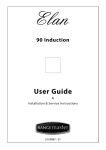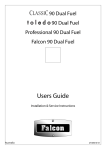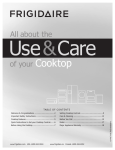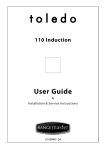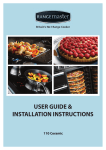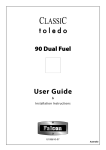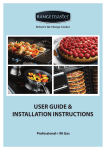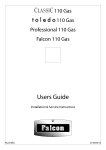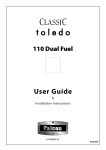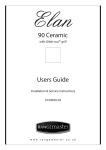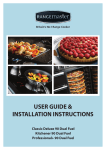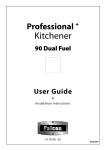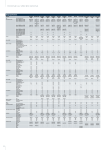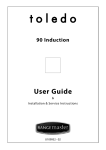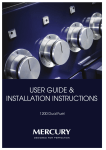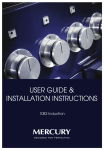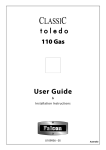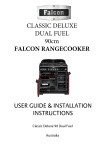Download User Guide - Cheminee Pty Ltd
Transcript
Elite ������������������������ 110 Dual Fuel User Guide & Installation & Service Instructions ArtNo.000-0008 Falcon logo shaded U109740-04 Australia Contents 1. Before You Start... 1 2. Cooker Overview 3 3. Cooking Tips 13 4. Cooking Table 14 5. Troubleshooting 15 6. Cleaning Your Cooker 17 7. Installation 21 8. Conversion to Propane Gas 30 9. Servicing 32 10. Circuit Diagram 38 11. Technical Data 39 Australia 1. Before You Start... Ventilation Thank you for buying this cooker. It should give you many years of trouble-free cooking if installed and operated correctly. It is important that you read this section before you start, particularly if you have not used a dual fuel cooker before. The use of a gas cooking appliance results in the production of heat and moisture in the room in which it is installed. Therefore, ensure that the kitchen is well ventilated: keep natural ventilation holes open or install a powered cooker hood that vents outside. If you have several burners on, or use the cooker for a long time, open a window or turn on an extractor fan. This appliance is designed for domestic cooking only. Using it for any other purpose could invalidate any warranty or liability claim. In particular, the oven should NOT be used for heating the kitchen – besides invalidating claims this wastes fuel and may overheat the control knobs. Personal Safety Installation and Maintenance DO NOT modify this appliance. Children or infirm people should be supervised to ensure that they do not play with the appliance. DO NOT use a steam cleaner to clean the cooker. The installation must be in accordance with the relevant instructions in this booklet, with the relevant national and local regulations, and with the local gas and electricity supply companies’ requirements. Ensure that the gas supply is turned on and that the cooker is wired in and switched on (the cooker needs electricity). Set the clock to ensure that the oven is functional - see the relevant section in this manual. The cooker should be serviced only by a qualified service engineer, and only approved spare parts should be used. Always allow the cooker to cool and then switch it off at the mains before cleaning or carrying out any maintenance work, unless specified otherwise in this guide. Before using for the first time, make sure that all packing materials have been removed and then, to dispel manufacturing odours, turn the ovens to 200°C and run for an hour. Always be certain that the controls are in the OFF position when the oven is not in use, and before attempting to clean the cooker. When the oven is on, DO NOT leave the oven door open for longer than necessary – otherwise, the control knobs may become very hot. Cooking high moisture content foods can create a ‘steam burst’ when an oven door is opened. When opening the oven stand well back and allow any steam to disperse. Make sure the room is well ventilated to the outside air (see ‘Ventilation’ below). People with respiratory or allergy problems should vacate the area for this brief period. ArtNo.324-0001 Steam burst If you smell gas: • • • • • • • Accessible parts will become hot during use and will retain heat even after you have stopped cooking. Keep babies and children away from the cooker and never wear loose-fitting or hanging clothes when using the appliance. Peculiar Smells When you first use your cooker it may give off a slight odour. This should stop after a little use. This appliance is not intended for use by persons (including children) with reduced physical, sensory or mental capabilities, or lack of experience and knowledge, unless they have been given supervision or instruction concerning use of the appliance by a person responsible for their safety. DO NOT turn electric switches on or off. DO NOT smoke DO NOT use naked flames DO turn off the gas at the meter or cylinder DO open doors and windows to get rid of the gas DO keep people away from the area affected Call your gas supplier. 1 DO NOT use harsh abrasive cleaners or sharp metal scrapers to clean the oven door glass since they can scratch the surface, which may result in shattering of the glass. Always keep combustible materials, e.g. curtains, and flammable liquids a safe distance away from your cooker. Do not store flammable materials in the storage drawer or near this appliance. Australia Cleaning DO NOT spray aerosols in the area of the cooker while it is on. In the interests of hygiene and safety, the cooker should be kept clean at all times as a build up in fats and other food stuff could result in a fire. Use dry oven gloves when applicable – using damp gloves might result in steam burns when you touch a hot surface. Do not use a towel or other bulky cloth in place of a glove – it might catch fire if brought into contact with a hot surface. NEVER operate the cooker with wet hands. NEVER heat unopened food containers. Pressure build up may cause the containers to burst and cause injury. DO NOT use unstable saucepans. Always ensure that you position the handles away from the edge of the hotplate. Clean only the parts listed in this guide. Clean with caution. If a wet sponge or cloth is used to wipe spills on a hot surface, be careful to avoid steam burns. Some cleansers can produce noxious fumes if applied to a hot surface. DO NOT use aluminium foil to cover shelves, linings or the oven roof. Never leave the hotplate unattended at high heat settings. Pans boiling over can cause smoking, and greasy spills may catch on fire. Use a deep fat thermometer whenever possible to prevent fat overheating beyond the smoking point. Never leave a chip pan unattended. Always heat fat slowly, and watch as it heats. Deep fry pans should be only one third full of fat. Filling the pan too full of fat can cause spill over when food is added. If you use a combination of oils or fats in frying, stir them together before heating, or as the fats melt. Foods for frying should be as dry as possible. Frost on frozen foods or moisture on fresh foods can cause hot fat to bubble up and over the sides of the pan. Carefully watch for spills or overheating of foods when frying at high or medium high temperatures. Never try to move a pan of hot fat, especially a deep fat fryer. Wait until the fat is cool. Do not use the top of the flue (the slot along the back of the cooker) for warming plates, dishes, drying tea towels or softening butter. DO NOT use water on grease fires and never pick up a flaming pan. Turn the controls off and then smother a flaming pan on a surface unit by covering the pan completely with a well fitting lid or baking tray. If available, use a multipurpose dry chemical or foam-type fire extinguisher. Take care that no water seeps into the appliance. Only certain types of glass, glass-ceramic, earthenware or other glazed containers are suitable for hotplate cooking; others may break because of the sudden change in temperature. This appliance is heavy so take care when moving it. 2 Australia 2. Cooker Overview DocAUS.020-0004 - Overview - 110DF - Elan Fig.2-1 � 0 0 0 0 0 0 0 0 0 0 � �� �� M � � � � ArtNo.215-0009 - 110 Elan DF The 110 dual fuel cooker (Fig.2-1) has the following features: A. B. C. D. E. F. Fig.2-2 6 hotplate burners including 2 wok burners A control panel A glide-out grill Main multi-function oven Fan oven Storage drawer ArtNo215-0001 knob centre full Hotplate Burners The drawing by each of the central knobs indicates which burner that knob controls. Each burner has an FSD that prevents the flow of gas if the flame goes out. When the igniter button is pressed in, sparks will be made at every burner – this is normal. Do not attempt to disassemble or clean around any burner while another burner is on, otherwise an electric shock could result. To light a burner, press the igniter button, and push in and turn the associated control knob to the high position as indicated by the large flame symbol (), (Fig.2-2). 3 Australia The igniter should spark and light the gas. Keep holding the knob pressed in to let the gas through to the burner for about ten seconds. Fig.2-3 If, when you let go of the control knob, the burner goes out, then the FSD has not been bypassed. Turn the control knob to the OFF position and wait for one minute before you try again, this time making sure to hold in the control knob for slightly longer. ArtNo215-0033 knob LH hotplate low Adjust the flame height to suit by turning the knob clockwise (Fig.2-3). If a burner flame goes out, turn off the control knob and leave it for one minute before relighting it. Fig.2-4 Ensure that the flames are under the pans. Using a lid will help the contents boil more quickly (Fig.2-4). Large pans should be spaced well apart. Pans and kettles with concave bases or down turned base rims should not be used (Fig.2-5). Simmering aids, such as asbestos or mesh mats, are NOT recommended (Fig.2-6). They will reduce burner performance and could damage the pan supports. ArtNo.311-0001 Right pans gas Fig.2-5 You should also avoid using unstable and misshapen pans that may tilt easily, and pans with a very small base diameter, e.g. milk pans, single egg poachers (Fig.2-7). ArtNo.311-0002 Pan with rim The minimum recommended pan diameter is 120mm. The maximum allowable pan base diameter is 250mm. DO NOT use cooking vessels on the hotplate that overlap the edges. Fig.2-6 Wok Burners The wok burners are designed to provide even heat over a large area. They are ideal for large pans and stir frying (Fig.2-8). For heating smaller pans, the aforementioned hotplate burners may be more efficient. ���������������������������� Fig.2-7 You can remove the burner parts for cleaning; see ‘Cleaning your cooker’. ArtNo.311-0004 Tipping wok You should wipe the enamel top surface of the cooker around the hotplate burners as soon as possible after spills occur. Try to wipe them off while the enamel is still warm. Note: The use of aluminium pans may cause metallic marking of the pan supports. This does not affect the durability of the enamel and may be cleaned off with an appropriate metal cleaner. Fig.2-8 ArtNo.311-0047 - Elan 110 Wok burner 4 Australia The Wok Cradle ArtNo.311-0006 Correct wok sizes The wok cradle is designed to fit a Professional 35cm Wok (available from our cookware collection – Part Code RM095). If you use a different Wok, make sure that it fits the cradle. Woks vary very widely in size and shape. It is important that the Wok sits down on the pan support – however, if the Wok is too small, the cradle will not support it properly (Fig.2-9). The cradle should be used on the triple ring wok burners only. When you fit the cradle, check that the wok is properly located on the front and rear fingers and that it is supported properly on a pan support (Fig.2-10). Fig.2-9 Fig.2-10 Make sure that the cradle is stable and that the Wok is sitting level in the ring. The cradle will get very hot in use – allow plenty of time for it to cool before you pick it up. The Griddle ArtNo.311-0007 Wok stand close-up The griddle fits the centre left pan support, front to back (Fig.2-11). It is designed for cooking food on directly. DO NOT use pans of any kind on it. The griddle surface is non-stick and metal cooking utensils (e.g. spatulas) will damage the surface. Use heat resistant plastic or wooden utensils. DO NOT put it crossways – it will not fit properly and will be unstable. DO NOT put it on any other burner – it is not designed to fit in any of the other pan supports. Fig.2-11 ArtNo.215-0007 - Elan 110 griddle on hotplate Position the griddle over the hotplate burners resting on the pan support (Fig 2-12). Check that it is securely located. Fig.2-12 The griddle can be lightly brushed with cooking oil before use (Fig 2-13). Light the hotplate burners. Adjust the flame heights to suit. Preheat the griddle for a maximum of 5 minutes before adding food. Leaving it longer may cause damage. Turn the control knobs towards the low position, marked with the small flame symbol, to reduce the burner flames. Always leave space around the griddle for the gases to escape. NEVER fit two griddles side by side (Fig 2-14). ArtNo.215-0008 - Elan 110 griddle - wrong ArtNo.311-0009 Oil on griddle After cooking, allow the griddle to cool before cleaning. ArtNo.311-0008 Griddle positioning 5 Fig.2-13 Fig.2-14 Australia The Glide-out Grill Fig.2-15 Open the door and pull the grill pan carriage forward using the handle (Fig.2-15). The grill has two elements that allow either the whole area of the pan to be heated or just the right-hand half. Adjust the heat to suit by turning the knob. To heat the whole grill, turn the knob clockwise (Fig.2-16). To heat the right-hand half, turn the knob anti-clockwise. The neon indicator light by the grill control will come on. ArtNo.331-0001Grill pan pulled forwards For best results, slide the carriage back into the grill chamber and preheat the appropriate part(s) of the grill for two minutes. The grill trivet can be removed and the food placed on it while you are waiting for the grill to preheat. 0 Fig.2-16 DO NOT leave the grill on for more than a few moments without the grill pan underneath it, otherwise the knobs may become hot. Once the grill has preheated, slide the carriage out again. With the trivet back in place with the food on it, slide the carriage back into the grill chamber. Ensure that it is pushed right in. ArtNo.216-0003 - Elan MF grill control Fig.2-17 Accessible parts may be hot when the grill is in use. Young children should be kept away. The grill pan grid can be turned over to give two grilling positions (Fig.2-17). Do not leave the grill on for more than a few moments, without the grill pan underneath it. ArtNo.331-0002 Grill pan high/low position The Ovens Function Use Defrost To thaw small items in the oven without heat Fan oven A full cooking function, even heat throughout, great for baking Fanned grilling Grilling meat and fish with the door closed Fan assisted A full cooking function good for roasting and baking Conventional oven A full cooking function for roasting and baking in the lower half of the oven The clock must be set to the time of day before the ovens will work. See the following section on ‘The Clock’ for instructions on setting the time of day. References to ‘left-hand’ and ‘right-hand’ ovens apply as viewed from the front of the appliance. The left-hand oven is a programmable multi-function oven, while the right-hand oven is a fanned oven. The Left-Hand Multi-function Oven As well as the oven fan and fan element, they are fitted with two extra heating elements, one visible in the top of the oven and the second under the oven base. Take care to avoid touching the top element and element deflector when placing or removing items from the ovens. To brown and crisp cheese topped Browning element dishes Base heat Never close the grill door when the grill is on. To crisp up the bases of quiche, pizza or pastry The multi-function oven has 3 main cooking functions, fan, fan assisted and conventional cooking. These functions should be used to complete most of your cooking. Table 2-1 The browning element and base heat can be used in the latter part of the cooking process to fine tune the results to your particular requirements. Use fanned grilling for all your grilling needs and defrost to safely thaw small items of frozen food. Table 2-1 gives a summary of the multi-function modes. 6 Australia The multi-function ovens have many varied uses. We suggest Fan assisted oven you keep a careful eye on your cooking until you are familiar This function operates the fan, circulating air heated with each function. Remember – not all functions will beArtNo.030-0028 - Elan MF bysymbols the elements at the top and the base of the oven. suitable for all food types. The combination of fan and conventional cooking (top and base heat) makes this function ideal for cooking Please remember that all cookers vary – temperatures in your large items that need thorough cooking, such as a large meat new ovens may differ to those in your previous cooker. roast. Multi-function oven functions It is also possible to bake on two shelves at one time, although they will need to be swapped over during the cooking time, as the heat at the top of the oven is greater than at the base, when using this function. Defrost This function operates the fan to circulate cold air ArtNo.030-0028 - Elan MF small symbolsitems such only. No heat is applied. This enables as desserts, cream cakes and pieces of meat, fish and poultry to be defrosted. This is a fast intensive form of cooking; keep an eye on the food cooking until you have become accustomed to this function. Defrosting in this way speeds up the process and protects the food from flies. Pieces of meat, fish and poultry should be placed on a rack, over a tray to catch any drips. Be sure to wash the rack and tray after defrosting. Conventional oven (top and base heat) This function combines the heat from the top and base elements. It is particularly suitable for roasting and baking pastry, cakes and biscuits. ArtNo.030-0028 - Elan MF symbols Defrost with the oven door closed. Large items, such as whole chickens and joints should not be defrosted in this way. We recommend this be carried out in a refrigerator. Food cooked on the top shelf will brown and crisp faster than on the lower shelf, because the heat is greater at the top of the oven than at the base, as in ‘Fan assisted oven’ function. Similar items being cooked will need to be swapped around for even cooking. This means that foods requiring different temperatures can be cooked together, using the cooler zone in the lower half of the oven and hotter area to the top. Defrosting should not be carried out in a warm oven or when an adjoining oven is in use or still warm. Ensure that dairy foods, meat and poultry are completely defrosted before cooking. Browning element This function uses the element in the top of the oven only. It is a useful function for the browning or finishing of pasta dishes, vegetables in sauce, shepherds pie and lasagne, the item to be browned being already hot before switching to the top element. Fan oven This functionArtNo.030-0028 operates the fanMFand the heating - Elan symbols ArtNo.030-0028 MF symbols element around it.- Elan An even heat is produced throughout the oven, allowing you to cook large amounts quickly. Fan oven cooking is particularly suitable for baking on several Base heat shelves at one time and is a good ‘all-round’ function. It may This function uses the base element only. It will crisp be necessary to reduce the temperature by approximately ArtNo.030-0028 - Elan MF symbols up your pizza or quiche base or finish off cooking 10°C for recipes previously cooked in a conventional oven. the base of a pastry case on a lower shelf. It is also If you wish to preheat the oven, wait until the indicator light a gentle heat, good for slow cooking of casseroles in the has gone out before inserting the food. middle of the oven or for plate warming. Fanned grilling This function operates the fan whilst the top element ArtNo.030-0028 MF symbols is on. It- Elan produces a more even, less fierce heat than a conventional grill. For best results, place the food to be grilled, on a grid over a roasting tin, which should be smaller than a conventional grill pan. This allows greater air circulation. Thick pieces of meat or fish are ideal for grilling in this way, as the circulated air reduces the fierceness of the heat from the grill. The Browning and Base heat functions are useful additions to your oven, giving you flexibility to finish off items to perfection. The oven door should be kept closed while grilling is in progress, so saving energy. Note: Please remember that all cookers vary so temperatures in your new ovens may differ to those in your previous cooker. Right-hand fan oven The right-hand oven is a fanned oven that circulates hot air continuously, which means faster, more even cooking. The recommended cooking temperatures for a fanned oven are generally lower than a conventional oven. You will also find that the food needs to be watched and turned less than for normal grilling. Preheat this function before cooking. 7 Australia Fig.2-18 Operating the Ovens 0 0 Operating the left-hand multi-function oven The multi-function oven has two controls: a function selector and a temperature setting knob (Fig.2-18). Turn the function selector control to a cooking function. Fig.2-19 shows the control set for convectional oven cooking. Turn the oven temperature knob to the temperature required (Fig.2-20). The oven heating light will glow until the oven has reached the temperature you selected. It will then cycle on and off during cooking as the oven maintains the selected temperature (Fig.2-21). ����������� ArtNo.216-0002 - MF controls �������� Fig.2-19 0 0 Operating the right-hand fan oven Turn the oven knob to the desired temperature (Fig.2-20). The oven indicator light will glow until the oven has reached the temperature selected. It will then cycle on and off during cooking (Fig.2-21). ArtNo.216-0005 - Elan setting the MF oven Fig.2-20 Fig.2-21 0 0 ArtNo.316-0007 - 110 Elan oven setting �� ArtNo.316-0008 - Elan indicator light �� 8 Australia The Clock ArtNo.300-0004 2-button clock annotated You can use the timer (Fig.2-22) to turn the ovens on and off. The clock must be set to the time of day before the ovens will work. Fig.2-22 Setting the time of day When the clock is first connected, the display flashes ( 0.00) and () alternately. To set the time, turn and hold the Timer knob to the clock symbol () and at the same time turn the Adjusting knob left or right until the clock shows the time of day. � � A – Timer knob, B – Adjusting knob Remember this is a 24-hour clock. ArtNo.300-0005 2BC minute minder setting Let go of the Timer knob and it will spring back to the vertical, oven manual setting. Fig.2-23 IMPORTANT: The cooker will not operate unless the clock has been set. Note: When using a multi-function oven, first set the clock as required before selecting the oven function and setting the temperature. Minute Minder Fig.2-24 Turn the Timer knob to the right to the () minute minder setting – it should click into position (Fig.2-23). ArtNo.300-0006 2BC minute minder setting 2 Fig.2-25 ArtNo.301-0007 2BC Stopping the oven 1 Use the Adjusting knob to set the time you need (Fig.2-24). You can either turn the knob back to the vertical manual setting () to keep an eye on the time of day, or leave it in the () minute minder position as the time ticks down. To stop the beeper when it sounds, turn the Adjusting knob anti-clockwise. • The ‘cook period’, which is the length of time you want the oven to cook for. • The ‘stop time’, which is the time of day you want the oven to stop cooking. Fig.2-26 ArtNo.301-0008 2BC Stopping the oven 2 To stop the ovens at a specific time of day Turn the Timer knob to the () position (Fig.2-25). Use the Adjusting knob to set the time at which the oven(s) is to stop. You can set the oven to turn on at any time over the following 24-hour period. AUTO shows in the display (Fig.2-26). Turn the Timer knob to the ‘AUTO’ setting to return to the clock display. Once the set time is reached, the beeper sounds. Turn the Timer knob to the vertical () to return to manual cooking. To start and then stop the ovens using the Timer Before you set the clock, decide on both the ‘cook time’ and the ‘stop time’. You cannot set a start time directly – this is set automatically by a combination of the ‘cook time’ and ‘stop time’. Turn the Timer knob to the () position (Fig.2-27). 9 Fig.2-27 ArtNo.301-0009 2BC Setting the cooking timer Australia Fig.2-28 Use the Adjusting knob to set the ‘cook time’ you need (Fig.2-28). Fig.2-29 ArtNo.301-0010 2BC Setting the cooking time Turn the Timer knob to the () position. The display will show the current time of day plus the ‘cook time’ you just set. ArtNo.301-0008 2BC Stopping the oven 2 Use the Adjusting knob to set the ‘stop time’ required (Fig.2-29). Fig.2-30 The ‘stop time’ is displayed, followed by ‘AUTO’. Set the oven(s) to the cooking temperature you need; turn the Timer knob to the ‘AUTO’ setting. Fig.2-31 When your cooking is finished, the beeper sounds. Turn the Timer knob to the vertical () to return to manual cooking. ArtNo.301-0012 2BC Activating the key lock 2 Art No. 301-0011 2BC Activating the key lock 1 If you are out, don’t worry about the beeper going off – it stops on its own after a while. When you return, turn the Timer knob to the vertical () to return to manual cooking. AUTO is showing, but you want to revert to manual cooking Fig.2-32 Fig.2-33 You can cancel any automatic settings by briefly turning the Timer knob to the clock symbol () and then releasing it. ArtNo.301-0014 2BC Deactivating the key lock 1 ArtNo.301-0013 2BC Activating the key lock 3 Key Lock When the key lock is activated, the ovens are locked and will not come on. Fig.2-34 To activate the key lock Make sure that the clock is in manual mode and cancel any active programs. ������������������� ��������������������������� Turn and hold the Timer knob to the clock symbol () for about 8 seconds. ‘On’ appears on the display (Fig.2-30). Keep holding the Timer knob turned to the clock symbol () and turn the Adjusting knob clockwise until the key symbol () and ‘OF’ shows on the display (Fig.2-31). Release the knobs. The ovens are now locked, as confirmed by the display showing the time of day alongside the key symbol (Fig.2-32). Fig.2-35 � To turn off the key lock Turn and hold the Timer knob to the clock symbol () for about 8 seconds. ‘OF’ will appear on the display (Fig.2-33). Keep holding the Timer knob turned to the clock symbol () and turn the Adjusting knob clockwise until the key symbol () goes out on the display and ‘On’ shows (Fig.2-34). Let go of the knobs. ArtNo.320-0009 Oven shelf � � � After a few seconds, the display reverts to showing the time of day. A - Top view, B - Side view, C - Shelf guard, D - Front The shelf guard should be at the back pointing upwards The ovens can now be used normally. 10 Australia Accessories Fig.2-36 Oven Shelves � In addition to the flat shelves (Fig.2-35), some models are supplied with a drop shelf (Fig.2-36). The drop shelf increases the possibilities for oven shelf spacing. ArtNo.320-0010 Flat & drop shelves The oven shelves can be easily removed and refitted. � Pull the shelf forward until the back of the shelf is stopped by the shelf stop bumps in the oven sides (Fig.2-37). Lift up the front of the shelf so the back of the shelf will pass under the shelf stop and then pull the shelf forward (Fig.2-38). A - Flat shelf, B - Drop shelf Fig.2-37 To refit the shelf, line up the shelf with a groove in the oven side and push the shelf back until the ends hit the shelf stop. Lift up the front so the shelf ends clear the shelf stops, and then lower the front so that the shelf is level and push it fully back (Fig.2-39). Fig.2-38 ArtNo.320-0011 Removing the shelf 1 The Handyrack (Main Oven) ArtNo.320-0012 Removing the shelf 2 The Handyrack (Fig.2-40) fits to the left-hand oven door only. Food cooking on it is easy to attend to, because it is accessible when the door is open. Fig.2-39 The maximum weight that can be held by the Handyrack is 5.5kg (12lb). It should only be used with the supplied roasting tin, which is designed to fit the Handyrack. Any other vessel could be unstable. Additional roasting tins are available from our cookware collection – Part Code RM027. ArtNo.320-0013 Removing the shelf 3 It can be fitted at two different heights. One of the oven shelves must be removed and the other positioned to suit. Fig.2-40 When the Handyrack is used in its highest position, other dishes can be cooked on the bottom shelf position or base of the oven. When the Handyrack is used in its lowest position, other dishes can be cooked on the second shelf position or base of the oven. ArtNo.320-0014 Handyrack on LH door To fit the Handyrack, locate one side of it on the door bracket (Fig.2-41). Fig.2-41 Then spring the other side out to clip it onto the other bracket (Fig.2-42). ArtNo.320-0015 Fitting the Handyack 1 11 Fig.2-42 ArtNo.320-0016 Fitting the handyrack 2 Australia Main Oven Light Fig.2-43 Press the appropriate button to turn the light on (Fig.2-43). If the oven light fails, turn off the power supply before changing the bulb. See the ‘Troubleshooting’ section for details on how to change the bulb. ArtNo.320-0017 Main oven light ArtNo.342-0001 - Elan - Storage drawer Storage The bottom drawer is for storing oven trays and other cooking utensils (Fig.2-44). It can get very warm, so do not store anything in it that may melt or catch fire. Fig.2-44 To remove the drawer, pull it fully forward (Fig.2-45). Lift up the ends of the plastic clips (one each side) to release the catches holding the drawer to the side runners and at the same time pull the drawer forward and away from the side runners (Fig.2-46). For safety’s sake push the drawer runners back out of the way. To refit the drawer, pull the side rails fully out. Carefully move the drawer back between the rails and rest it on the side rails. Fig.2-45 At each side, hold the front of the drawer and pull the side rail forward so that the clips click into position, holding the drawer to the side rails (Fig.2-47). ArtNo.342-0003 - Elan drawer pulled out Fig.2-46 ArtNo.342-0002 - Elan - drawer position Fig.2-47 ArtNo.340-0004 - Elan - Refitting the drawer 12 Australia 3. Cooking Tips ArtNo.030-0002GB - Cooking tips - electric Tips on Cooking with the Timer General Oven Tips If you want to cook more than one dish, choose dishes that require approximately the same cooking time. However, dishes can be ‘slowed down’ slightly by using small containers and covering them with aluminium foil, or ‘speeded up’ slightly by cooking smaller quantities or placing them in larger containers. The wire shelves should always be pushed firmly to the back of the oven. Baking trays with food cooking on them should be placed level with the front edge of the oven’s wire shelves. Other containers should be placed centrally. Keep all trays and containers away from the back of the oven, as overbrowning of the food may occur. Very perishable foods such as pork or fish should be avoided if a long delay period is planned, especially in hot weather. For even browning, the maximum recommended size of a baking tray is 340mm (13½”) by 340mm (13½”). DO NOT place warm food in the oven to be timed. When the oven is on, do not leave the door open for longer than necessary, otherwise the knobs may get very hot. DO NOT use a timed oven that is already warm. DO NOT use the timed oven if the adjoining oven is already warm. • Whole poultry must be thoroughly defrosted before being placed in the oven. Check that meat and poultry are fully cooked before serving. • • • • • 13 Always leave a ‘fingers width’ between dishes on the same shelf. This allows the heat to circulate freely around them. To reduce fat splashing when you add vegetables to hot fat around a roast, dry them thoroughly or brush lightly with cooking oil. Where dishes may boil and spill over during cooking, place them on a baking tray. The Cook & Clean oven liners (see ‘Cleaning Your Cooker’) work better when fat splashes are avoided. Cover meat when cooking. Sufficient heat rises out of the oven while cooking to warm plates in the grill compartment. If you want to brown the base of a pastry dish, preheat the baking tray for 15 minutes before placing the dish in the centre of the tray. DocNo.031-0002 - Cooking table Australia 4. Cooking Table The oven control settings and cooking times given in the table below are intended to be used AS A GUIDE ONLY. Individual tastes may require the temperature to be altered to provide a preferred result. Top Centre Food is cooked at lower temperature in a fan oven than in a conventional oven. When using recipes, reduce the fan oven temperature by 10°C and the cooking time by 5-10 minutes. The temperature in the fanned oven does not vary with height in the oven so you can use any shelf. ArtNo.050-0007 Oven shelf positions Base Oven Shelf Positions Conventional Oven Fan Oven Temperature Shelf Temperature Food ArtNo.050-0003A - Cooking table - electric & fan °C position °C 160 C 150 200 C 190 160 C 150 200 C 190 160 C 150 200 C 190 160 C 150 20-25 minutes per 500g +20-25 minutes. 200 C 190 15-20 minutes per 500g +15-20 minutes. 160 C 150 20 minutes per 500g +20 minutes. 200 C 190 15 minutes per 500g +15 minutes. 160 C 150 25-30 minutes per 500g. 200 C 190 20 minutes per 500g. 140-150 C 130-140 220 T 210 Large tins 30-35 minutes; individual 10-20 minutes. Fillet 190 C/B 180 15-20 minutes. Whole 190 C/B 180 15-20 minutes per 500g. Steak 190 C/B 180 Steaks according to thickness. 140 C/B 130 45-50 minutes per 500g of mixture. Fruit 180 mm tin 150 C/B 140 2-2½ hours. Fruit 230 mm tin 150 C/B 140 Up to 3½ hours. Madeira 180 mm 160 C 150 80-90 minutes. Queen cakes 190 C 180 15-25 minutes. Scones 220 C 210 10-15 minutes. 180 mm tin 180 C 170 20-30 minutes. 210 mm tin 180 C 170 30-40 minutes. Shortcrust tarts 200 C 190 20-30 minutes on a preheated tray. Fruit pies 200 C 190 35-45 minutes. Tartlets 200 C 190 10-20 minutes according to size. Puff pastry 230 C 220 20-40 minutes according to size. Meringues 100 C 90 2-3 hours. Baked egg custard 160 C 150 45-60 minutes. 40-45 minutes. Meat Approximate cooking time ArtNo.050-0001 Gas cooking table Beef (no bone) Lamb Pork Poultry Chicken Turkey Duck Casserole Yorkshire pudding 30-35 minutes per 500g +30-35 minutes. Thoroughly thaw frozen joints before cooking. Meat may be roasted at 20-25 minutes per 500g +20-25 minutes. 220°C (210°C for fan oven) and the 30-35 minutes per 500g +30-35 minutes. cooking time adjusted accordingly. 25-30 minutes per 500g +25-30 minutes. For stuffed and rolled meats, add approximately 10 minutes per 500g, 35-40 minutes per 500g +35-40 minutes. or cook at 200°C (190°C) for 20 25-30 minutes per 500g +25-30 minutes. minutes then 160°C (150°C) for the remainder. 2-4 hours according to recipe. For stuffed poultry, you could cook at 200°C (190°C) for 20 minutes then 160°C (150°C) for remainder. Do not forget to include the weight of the stuffing. For fresh or frozen prepacked poultry, follow instructions on the pack. Thoroughly thaw frozen poultry before cooking. Fish Cake Very rich fruit - Christmas, wedding, etc. Victoria sandwich Using the conventional oven: when two tier cooking leave at least one runner space between shelves. Position the baking tray with the front edge along the front of the oven shelf. Up to three tiers can be cooked in a fan oven at the same time but make sure to leave at least one runner space between each shelf being cooked on. Desserts Baked sponge pudding Milk pudding Bread 190 C 180 140-150 C/B 130-140 220 C/T 210 2 to 3 hours. 20-30 minutes. 14 Using the conventional oven: for even browning the maximum size of baking tray recommended is 340mm x 340mm. This ensures free heat circulation. If cooking a two tier load, the trays should be interchanged approximately halfway though the cooking time. Australia 5. Troubleshooting Steam is coming from the oven When cooking foods with a high water content (e.g. oven fries) there may be some steam visible at the rear grille. Take care when opening the oven door, as there may be a momentary puff of steam when the oven door is opened. Stand well back and allow any steam to disperse. The oven is not cooking evenly If you are cooking a large item, be prepared to turn it round during cooking. If two racks are used, check that space has been left for the heat to circulate. When a baking sheet is put into the oven, make sure it is placed centrally on the rack. Check that the door seal is not damaged. An oven fan is noisy The note of the oven fan may change as the oven heats up – this is perfectly normal. A dish of water when placed on the rack should be the same depth all over. (For example, if it is deeper at the back, then the back of the range should be raised up or the front lowered). What cleaning materials are recommended for the range? See the ‘Cleaning’ section for a full list of recommended cleaning materials. If the range is not level arrange for your supplier to level it for you. Oven not coming on Is the power on? We do not recommend corrosive or caustic cleaners as these may damage your range. If not there may be something wrong with the power supply. Is the range supply on at the circuit breaker? The knobs get hot when I use the oven, can I avoid this? Yes, this is caused by heat rising from the oven, and heating them up. Do not leave the oven door open. Have you set a cooking function? If there is an installation problem and I don’t get my original installer to come back to fix it who pays? Oven temperature getting hotter as the range gets older You do. Service organizations will charge for their call outs if they are correcting work carried out by your original installer. It is in your interest to track down your original installer. If turning the knob down has not worked or only worked for a short time then you may need a new thermostat. This should be installed by a service technician (see the ‘Service and Parts’ section of the instructions). If there is an installation problem and I don’t get my original installer to come back to fix it, who pays? You do. Service organisations will charge for their call outs if they are correcting work carried out by your original installer. It’s in your interest to track down your original installer. Oven temperature getting hotter as the cooker gets older If turning the knob down has not worked or only worked for a short time then you may need a new thermostat. This should be fitted by a service person. An oven light is not working The bulb has probably burnt out. You can buy a replacement bulb (which is not covered under the warranty) from a good electrical shop. Ask for a 15W – 230V lamp, FOR OVENS. It must be a special bulb, heat resistant to 300°C (Fig.5-1). Current Operated Ground Fault Circuit Breaker Where the range installation is protected by a 30mA sensitivity residual current device (RCD), the combined use of your range and other domestic appliances may occasionally cause nuisance tripping. Turn off the power at the circuit breaker. Food is cooking too slowly, too quickly, or burning Cooking times may differ from your previous oven. Check that you are using the recommended temperatures and rack positions. See the oven cooking guide section of the instructions. The oven control settings and cooking times are intended to be used only as a guide. Individual tastes may require the temperature to be altered either way, to get the results you want. Try cooking at a higher temperature setting. Make sure the oven is cool. Open the oven door and remove the oven racks. Unscrew the bulb cover by turning counter clockwise. It may be very stiff (Fig.5-2). Taking care to protect your fingers in case the bulb should shatter, unscrew the old bulb. Screw in the new bulb; screw back the bulb cover. Turn on the circuit breaker and check that the bulb now lights. 15 Australia Hotplate ignition or cooktop burners faulty Is the power on? Fig.5-1 Are the sparker (ignition electrode) or burner holes blocked by debris? ArtNo.324-0005 Oven light bulb Are the burner heads correctly located? See the section entitled ‘Cleaning’. Remember that each cooktop burner has a special safety device that stops the flow of gas if the flame goes out. When lighting a cooktop burner the safety device has to be overridden by holding in the control knob so that the gas can flow. This allows the flame sensor to heat up and operate the safety device. Keep holding the knob pressed in to let the gas through to the burner for few seconds. The igniter should spark and light the gas. Fig.5-2 If, when you let go of the control knob, the burner goes out, the safety device has not held in. Turn the control to the off position and wait one minute, then try again this time holding in the control knob for slightly longer. ArtNo.324-0007 Unscrewing the bulb cover Hotplate burners will not light If only one or all the cooktop burners will not light, make sure that the parts have been replaced correctly after wiping or removing for cleaning. Check that there is not a problem with your gas supply. You can do this by making sure that other gas appliances you may have are working. Do the burners spark when you push in the control knob? If not check the power is on. 16 Australia 6. Cleaning Your Cooker Fig.6-1 Doc AUS.040-0004 - Cleaning - 110DF - GO grill Isolate the electricity supply before carrying out any major cleaning. Allow the cooker to cool. � Never use paint solvents, washing soda, caustic cleaners, biological powders, bleach, chlorine based bleach cleaners, coarse abrasives or salt. Do not mix different cleaning products – they may react together with hazardous results. � � All parts of the cooker can be cleaned with hot soapy water – but take care that no surplus water seeps into the appliance. � � Remember to switch the electricity supply back on and reset the clock before reusing the cooker. ArtNo.311-0013 Burner layout A - Cap, B - Head, C - Notch, D - Electrode, E - Base Fig.6-2 Daily Care ArtNo.311-0014 Wok burner details � Cleaning the range is not a welcomed chore, but it has to be done to maintain efficiency and appearance. Remember it is better to wipe up any spills as they occur, this will prevent them burning on and becoming more difficult to remove later. � Make sure the flow of combustion and ventilation air to the range is unobstructed – for example by buildup of fats or grease. � � On Natural Gas the burners flames should be a bluish colour with, at most, a slight yellowish fringe. On LP gas the flames may be “softer”. The cooktop burner flames may have a slight yellowish tip. If the flame burns with a long white tip you should call for service. � Cleaning for Spills A - Inner burner cap, B - Outer burner cap, C - Inner burner head, D - Outer burner head, E - Wok burner base For spills and boil-overs that occur while cooking, turn off the burner as soon as possible and allow it to cool. Do not clean until the area is completely cooled down. Wipe up spills as soon as possible. ��� Fig.6-3 Do not allow surplus water to seep into the cooker. Hotplate Burners The burner heads and caps can be removed for cleaning. Make sure they are absolutely dry before replacing. ArtNo.311-0015 Burner alignment Fig.6-4 The Single Ring Burners When refitting the burner head, ensure that the notch lines up with the electrode or hole in the base. Check that the burner head is level and that the cap is fitted centrally on the burner head (Fig.6-1). � The Wok Burners When reassembling a wok burner (Fig.6-2) turn over the large base ring and find the ‘D’ shaped area (Fig.6-3). Turn the head until the ‘D’ matches the one on the burner base. Flip the burner over once again and place it on the burner base. � ArtNo.311-0016 Fitting the burner inner head To fit the small inner burner, find the larger electrode notch in the burner rim. Line this up with the ignition electrode and place the inner burner on the large base ring (Fig.6-4). A - Electrode notch, B - Ignition electrode 17 Australia Now fit the two burner caps, ensuring that they are seated properly. Fig.6-5 Check the burner ports are not blocked. If a blockage occurs, remove stubborn particles using a piece of fuse wire. The Wok Cradle Recommended cleaning materials are hot soapy water, a moistened soap pad, cream cleaner or nylon scourer. ArtNo.331-0001Grill pan pulled forwards Fig.6-6 Griddle ArtNo.331-0003 Grill frame out, no pan Always clean the griddle after use. Allow it to cool completely before removing. Immerse the griddle plate in hot soapy water. Use a soft cloth or, for stubborn stains, a nylon washing up brush. Never use caustic or abrasive cleaners, as these will damage the surface. If the griddle is cleaned in a dishwasher residue may appear on the underside. This is perfectly safe and will not affect the cooking surface. Glide-out Grill The grill pan and grid should be washed in hot soapy water. After grilling meats or any foods that soil, leave to soak for a few minutes immediately after use. Stubborn particles may be removed from the grid using a nylon brush. Alternatively, the grill pan can be washed in a dishwasher. Fig.6-7 Before you remove any of the grill parts for cleaning, ensure that they are cool, or use oven gloves. The grill pan can be easily removed for cleaning as follows. Remove the grill pan support frame by pulling the grill pan forward (Fig.6-5). ArtNo.331-0004 Removing the grill frame Lift the grill pan clear of the support frame. The support frame is held to the side rails by two clips on each side (Fig.6-6). Fig.6-8 For each side, support the side rail with one hand and with the other hand lift the frame up and out of the side clips (Fig.6-7). For safety, push the side rails back into the grill chamber. If you need to remove the side rails to allow cleaning of the grill chamber, you can unhook them from the grill chamber sides (Fig.6-8) and wipe the sides clean with a soft cloth and mild detergent. ArtNo.331-0005 Removing the grill rail Fig.6-9 DO NOT use any abrasive substances. DO NOT put the side runners in a dishwasher. Once you have finished, hook the side rails back onto the sides of the chamber. To refit the frame, pull the side rails forward and, for each side in turn, support the side rail and press the frame down into the side rails. Replace the grill pan. When refitting the grill pan, ensure that the wide rim is at the front (Fig.6-9). ArtNo.331-0006 Grill pan plan 18 Australia Control Panel and Doors Fig.6-10 Avoid using any abrasive cleaners, including cream cleaners, on brushed stainless steel surfaces. For best results, use a liquid detergent or our Multi-purpose Cleaner. The same cleaner can also be used on the doors. Alternatively, use a soft cloth wrung out in clean hot soapy water. You can use the same method for cleaning the control panel and knobs (although we do supply a specialist Fascia Cleaner). After cleaning, polish with a dry cloth. ArtNo.320-0002c - Oven door side screws (Elan) Ovens The oven door front panels can be taken off so that the glass panels can be cleaned. Move the cooker forward to gain access to the sides (see the ‘Moving the Cooker’ section under ‘Installation’). Fig.6-11 Door Panel Open the oven door slightly and remove the front panel fixing screws from the door sides, two each side (Fig.6-10). Carefully lift off the outer door panel. The inside face of the glass panels can now be cleaned – take care not to disturb or wet the door insulation. ArtNo.320-0008 Removing the oven lining Note: If the door is triple glazed then the inner two panels are fixed together and should not be separated. After cleaning, carefully refit the outer door panel and replace the side fixing screws. DO NOT use harsh abrasive cleaners or sharp metal scrapers to clean the oven door glass since they can scratch the surface, which may result in shattering of the glass. 'Cook & Clean' Panels The main oven has side ‘Cook & Clean’ panels which have been coated with a special enamel that partly cleans itself. This does not stop all marks on the lining, but helps to reduce the amount of manual cleaning needed. These panels work better above 200°C. If you do most of your cooking below this temperature, occasionally remove the panels and wipe with a lint free cloth and hot soapy water. The panels should then be dried and replaced and the oven heated at 200°C for about one hour. This will ensure that the panels are working effectively. Removing the Panels to clean the Enamel Interior If you wish to clean the enamel interior of the oven, you will need to remove the shelves, followed by the ‘Cook & Clean’ panels. Each side of the oven is fixed with four fixing screws. You do not have to remove the screws to remove the oven panels. Simply lift each side panel upwards, slide them off the screws and then pull them forwards (Fig.6-11). Once the panels have been removed, the oven enamel interior can be cleaned. DO NOT use steel wool, oven cleaning pads, or any other materials that will scratch the surface. 19 Australia Cleaning Table Cleaners listed are available from supermarkets or electrical retailers as stated. For enamelled surfaces use a cleaner that is approved for use on vitreous enamel. Regular cleaning is recommended. For easier cleaning, wipe up any spillages immediately. To help keep your oven clean, cover meat when roasting, with foil or use a roasting bag. Brush vegetables with fat before placing around the meat. Hotplate Part Finish Recommended Cleaning Method Hob Top Enamel or stainless steel Hot soapy water, soft cloth. Any stubborn stains remove gently with a nylon scourer. Electric Sealed Hob Plate Cast iron Remove rust and food debris with a well soaped steel wool pad along the grain. Rinse and allow to dry. Apply a proprietary sealed hotplate restorer (Electrical Retailers) to restore colour and protect the plates. Ceramic/Induction hob Toughened glass Hot soapy water; cream cleaner/scourer if necessary. Griddle Plate (some models only) Non-stick surface Allow to cool. Wash in hot soapy water. Do not use abrasive cleaners/scourers. Dishwasher. Warming Zone (some models only) Toughened glass Hot soapy water, cream cleaner/scourer if necessary. Part Finish Recommended Cleaning Method Door, Door surround and Storage Drawer exterior. Enamel or paint Hot soapy water, soft cloth. Any stubborn stains, remove gently with a liquid detergent. Stainless steel Microfibre plus all purpose cloth (supermarket) Sides and plinth Painted surface Hot soapy water, soft cloth Splashback/rear grille Enamel or stainless steel Hot soapy water, soft cloth. Cream cleaner, with care, if necessary. Control panel Paint, enamel or stainless steel Warm soapy water. Do not use abrasive cleaners on lettering. Control knobs/handles & trims Plastic/chrome or copper Warm soapy water, soft cloth. Brass Brass polish. Toughened glass Hot soapy water, cream cleaner/scourer if necessary. Outside of cooker Oven Door Glass/Glass Lid Oven and Grill Part Finish Recommended Cleaning Method Sides, floor, divider & roof of oven NOT COOK & CLEAN OVEN PANELS (see below) Enamel Cook & Clean Oven Panels (some models only) Special enamel that partly cleans itself Any proprietary oven cleaner that is suitable for enamel. CAUTION: CORROSIVE/CAUSTIC OVEN CLEANERS: FOLLOW MANUFACTURERS INSTRUCTIONS. Do not allow contact with the oven elements. This surface cleans itself at 200°C and above, or the panels can be removed and washed with hot soapy water and a nylon brush (see ‘The Ovens’ in ‘Cleaning your cooker’). Oven Shelves, Handyrack, Grill Trivet, Handygrill rack Chrome An oven interior cleaner that is suitable for chrome. Soap filled pad. Dishwasher. Grill Pan/Meat Tin (some models only) Enamel Hot soapy water. Soap filled pad. Dishwasher. 20 INSTALLATION Check the appliance is electrically safe and gas sound when you have finished. 7. Installation Service and Spares Firstly, please complete the appliance details below and keep them safe for future reference – this information will enable us to accurately identify the particular appliance and help us to help you. Filling this in now will save time and inconvenience if you later have a problem with the appliance. It may also be of benefit to keep your purchase receipt with this leaflet. You may be required to produce the receipt to validate a warranty field visit. Retailer’s Name and Address Andi-Co Appliance Pty Ltd. 1 Stamford Road, Oakleigh, VIC 3166 Tel: (03) 9569 1225 Fax: (03) 9569 1450 Email: [email protected] Name of Appliance Ceramic electric Appliance Serial Number* Fuel Type Electric Date of Purchase Installer’s Name, Address and Telephone No. Date of Installation * This information is on the appliance data badge If you have a problem In the unlikely event that you have a problem with your appliance, please refer to rest of this booklet, especially the problem solving section, first to check that you are using the appliance correctly. If you are still having difficulty, contact you retailer Please note If your appliance is outside the 12-month warranty period, our service provider may charge for this visit. If you request an engineer to visit and the fault is not the responsibility of the manufacture, our service provider reserves the right to make a charge. Appointments not kept by you may be subject to a charge. Out of Warranty We recommend that our appliances are serviced regularly throughout their life to maintain the best performance and efficiency. The frequency of service will depend on usage – for normal usage once a year should suffice. Service work should only be carried out by an suitably Authorised Person. Spare Parts To maintain optimum and safe performance, we recommend that only genuine spare parts are used. Do not use reconditioned or unauthorised controls. Contact your retailer. 21 INSTALLATION Check the appliance is electrically safe and gas sound when you have finished. Dear Installer Provision of Ventilation Before you start your installation, please complete the details below, so that, if your customer has a problem relating to your installation, they will be able to contact you easily. This appliance is not connected to a combustion products evacuation device. Particular attention shall be given to the relevant requirements regarding ventilation. The room containing the cooker should have an adequate air supply. ���������������� Install the cooker in a location to allow the complete combustion of gas, proper flueing and to maintain ambient temperature of the immediate surroundings at safe limits, under normal condition. ������������������� Location of Cooker ArtNo.050-0011 - Installer information table The cooker may be installed in a kitchen/kitchen diner but NOT in a room containing a bath or shower. ���������������������������� Note: An appliance for use on Propane must not be installed in a room or internal space below ground level, e.g. in a basement. Conversion ����������������������� All models are supplied set for use on Natural gas. A conversion kit for Propane gas is included with the appliance. See the instructions that are supplied with the conversion kit. After converting the appliance, please attach the Gas Conversion sticker over the appropriate area of the data badge – this will identify the gas type for which the appliance is now set. You must be aware of the following safety requirements & regulations. Prior to installation, ensure that the local distribution conditions (nature of the gas and gas pressure) and the adjustment of the appliance are compatible. The appliance must be installed in accordance with the regulations in force and only in a well ventilated space. Read the instructions before installing or using this appliance. The regulations and standards are as follows: AS 5601/AG601 – ‘Gas Installations’ In your own interest and that of safety, it is law that all gas appliances be installed by competent persons. Failure to install the appliance correctly could invalidate any warranty or liability claims and lead to prosecution. The cooker must be installed in accordance with all local gas fitting regulations, municipal building codes, electrical wiring regulations and any other relevant statutory regulations. WARNING! Where this appliance is installed in marine craft or in caravans, it shall NOT be used as a space heater. 22 INSTALLATION Check the appliance is electrically safe and gas sound when you have finished. You will need the following equipment to complete the cooker installation satisfactorily: • Restraining chain: If the cooker is to be supplied with gas through a flexible hose, a restraining chain must be fitted. • Flexible gas hose. • Gas pressure tester/manometer • Multimeter: For electrical checks Checking the Parts: Levelling tool 4 pan supports ArtNo.020-0022 Levelling tool V2 Griddle plate Wok cradle You will also need the following tools: 1. 2. 3. 4. 5. 6. 7. 8. 9. 10. 11. Electric drill Masonry drill bit (only required if fitting the cooker on a stone or concrete floor) Wall plugs (only required if fitting the cooker on a stone or concrete floor) Steel tape measure Cross head screwdriver Flat head screwdriver 4mm & 3mm Allen keys Spirit level Pencil Adjustable spanner Screws for fitting the restraining chain ArtNo.000-0009 Wok ring, cast ArtNo.000-0008 Griddle Grill pan & trivet Flat shelves & drop shelves ArtNo.324-0011 Flat & drop shelves ArtNo.330-0001 - Grill pan Roasting tin Handyrack ArtNo.324-0003 Handyrack ArtNo.324-0004 Roasting tin Splashback Plinth ArtNo.350-0005 - 90 plinth ArtNo.421-0002 - Splashback Stability bracket ArtNo.020-0013 Stability bracket 23 Restraining chain & hook ArtNo.020-0021 - Restraining chain & hook INSTALLATION Check the appliance is electrically safe and gas sound when you have finished. Positioning the Cooker Fig.7-1 The diagram (Fig.7-1) shows the minimum recommended distance from the cooker to nearby surfaces as given in AS 5601 / AG 601. 1. � The minimum height of any surface above the cooker is 650mm above the hotplate. � � � � Overhead – Measurement A Range hoods and exhaust fans shall be installed in accordance with the manufacturer’s instructions. However, in no case shall the clearance between the highest part of the hob of the cooking appliance and a range hood be less than 650mm or, for an overhead exhaust fan, 750mm. 2. ArtNo.110-0023 - 110 - cooker clearances (AUS) Side Clearances – Measurements B & C Where B, measured from the periphery of the nearest burner to any vertical combustible surface, or vertical combustible surface covered with toughened glass or sheet metal, is less than 200mm, the surface shall be protected to ensure that the combustible surface does not exceed 65ºC above ambient*. Even with the surface protected, the dimension B should not be less than 135mm above hotplate level. Fig.7-2 *The fixing of 5mm thick ceramic tiles to the surface, or attaching fire resistant material to the surface and covering with sheet metal with a minimum thickness of 0.4mm to a height C of not less than 150mm above the hotplate, should satisfy this requirement. 3. ������� ������� Side Clearances – Measurement D & E Where D, the distance from the periphery of the nearest burner to a horizontal combustible surface is less than 200mm, then E shall be 10mm or more, or the horizontal surface shall be above the trivet. ArtNo.110-0005 110 door clearances Fig.7-3 A clearance of 130mm is required if the cooker is near a corner of the kitchen, to allow the oven doors to open. The actual opening of the doors is slightly less, but this allows for some protection of your hand as you open the door (Fig.7-2). We recommend a gap of 1110mm between units to allow for moving the cooker. Do not box the cooker in - it must still be possible to move the cooker in and out for cleaning and servicing. ArtNo.010-0001 Removing the packaging Moving the Cooker Fig.7-4 On no account try and move the cooker while it is plugged into the electricity supply. The cooker is very heavy, so take great care. We recommend two people manoeuvre the cooker. Ensure that the floor covering is firmly fixed, or removed to prevent it being disturbed when moving the cooker around. ArtNo.342-0003 - Elan drawer pulled out From the back tilt the cooker forward and remove the rear half of the polystyrene base pack (Fig.7-3). Repeat from the front and remove the front half of the poly base. Pull the drawer out to its furthest point (Fig.7-4). 24 INSTALLATION Check the appliance is electrically safe and gas sound when you have finished. Lift up the ends of the plastic clips (one each side) to release the catches holding the drawer to the side runners and at the same time pull the drawer forward and away from the side runners (Fig.7-5). Fig.7-5 For safety’s sake push the drawer runners back out of the way. Put the drawer somewhere safe - do not refit it until the installation is complete. ArtNo.342-0002 - Elan - drawer position First fit the levelling tool on the hexagonal adjusting nut (Fig.7-6). Make 10 complete (360º) turns clockwise (Fig.7-7) - this means turning and removing the levelling tool 20 times. Make sure you lower BOTH REAR ROLLERS. There are two adjusting nuts, one for each roller, at both the front bottom corners of the cooker. Fig.7-6 ArtNo.010-0002 Rear roller nut Completing the Move Unfold the rear edge of the pack base tray. Grip the fascia panel and lift the front of the cooker slightly (Fig.7-8). Carefully push the cooker backwards off the pack base. Remove the pack base. Position the cooker close to its final position, leaving just enough space to get behind it (Fig.7-9). DO NOT use the control knobs to manoeuvre the cooker. Fig.7-7 Levelling You are recommended to use a spirit level on a shelf in one of the ovens to check for level. ArtNo.010-0010 Lowering the rear rollers (90) Place the cooker in its intended position, taking care not to twist it within the gap between the kitchen units as damage may occur to the cooker or the units. x10 The front feet and rear rollers can be adjusted to level the cooker. To adjust the height of the rear of the cooker use the levelling tool supplied to turn the adjusting nuts at the front bottom corners of the cooker. To set the front feet turn the bases to raise or lower. Fig.7-8 Leave the levelling tool in the storage drawer, so that the customer can use it if they wish to move the cooker. Fig.7-9 ArtNo.010-0009 Pushing the cooker ArtNo.010-0004 Moving the cooker 25 INSTALLATION Check the appliance is electrically safe and gas sound when you have finished. Fitting the Splashback Fig.7-10 The splashback fits the back of the cooker. It is secured using 4 screws (2 at each end) in the rear edge of the flue grille. Remove the outer 2 screws and then loosen the inner pair. Fit the splashback over the inner screws and then refit the outer screws (Fig.7-10). Tighten all screws to secure. ArtNo.421-0001 - Fitting a splashback Classic Stability Bracket and Chain A stability bracket and chain should be fitted when the cooker is connected to a flexible gas supply. Unless properly installed, the cooker could be tipped by leaning on the door. Injury might result from spilled hot liquids or from the cooker itself. Fig.7-11 � IMPORTANT: The cooker must be set to the correct height and levelled before the stability bracket is installed. � Fitting a Stability Bracket (Fig.7-11 and Fig.7-12) ����� A stability bracket or chain (not supplied by with the cooker) should be fitted when the cooker is connected to a flexible gas supply. ArtNo.110-0010 Fitting the stability bracket When fitting a stability bracket read these instructions together with the leaflet supplied with the bracket. ����� ����� � A - Levelling rollers, B - Levelling feet, C - Wall face, D - Pencil line on the floor Fig.7-12 � 1. Place the cooker in its intended position and level the cooker. 2. Draw a pencil line 100mm from the front edge of the levelling feet. 3. Mark the centre line for the bracket by measuring 550mm from the left hand side of the cooker. 4. Lower the front roller and move the cooker forward. 5. Measure back from the pencil line 550mm to locate the front edge of the bracket. Fix the bracket to the floor. 6. Measure the height from floor level to engagement edge in back of cooker. Add 3mm to this dimension and assemble the stability bracket to this height (i.e. from floor level to underside of the top member) and ensure the bracket does not foul the oven burner assembly. � � ArtNo.070-0005 - Stability bracket Fig.7-13 ArtNo.070-0011 - Elan bracket holes Fitting the Restraining Chain The restraining chain MUST be fitted. ��������� ������������� The length of chain between the appliance and the wall fixing should prevent strain on the gas and electricity connections, but still allow access to unhook the chain when the cooker is pull forward. Fix the supplied hook securely to the wall. Measure the length of chain required. Use the hexagonheaded screw, washers and bolt supplied in the restraining chain kit to fix the chain to one of the holes at the top of the flue trim bracket (Fig.7-13). Hook the other end of the chain to the wall fixing. 26 INSTALLATION Check the appliance is electrically safe and gas sound when you have finished. Gas Connection ��� ��� Must be in accordance with the relevant standards. The gas supply needs to terminate with a down facing bayonet. � Fig.7-14 ��� Because the height of the cooker can be adjusted and each connection is different it is difficult to give precise dimensions. The hose should be fitted so that both inlet and outlet connections are vertical so that the hose hangs downwards in a ‘U’ shape (Fig.7-14). ��� The connector is located just below the hotplate level at the rear of the cooker. A flexible connection is supplied with the cooker. If it is necessary to use another hose it must be to A.S. 1869 class B and be suitable for your gas type. If in doubt contact your supplier. Screw connect the threaded end of the hose into the gas inlet. ArtNo.090-0027 - 90 Elan gas connections After completing the gas connection, check the cooker is gas sound with a pressure test. A - Position of gas supply connector, B - Appliance gas inlet Pressure Testing The pressure test point is accessible on the inlet pipe at the rear. Remove the test nipple screw and fit a pressure gauge to the test point. Turn on and light two of the hotplate burners. For Natural Gas cookers the pressure should be 1kPa. For Propane X cookers the pressure should be 2.54kPa. Electrical Connection This appliance must be installed by a qualified electrician to comply with the relevant regulations (AS/NZS 60335.2.6:2002) and also the local electricity supply company requirements. Ensure that the mains characteristics (voltage, nominal, power, etc.) match the ratings indicated on the data plate affixed to the cooker. The cooker is preset for a single-phase earthed electrical connection. It is essential to install a multi-pole circuit breaker that completely disconnects the appliance from the mains, with a minimum contact break distance of 3mm. WARNING: THIS APPLIANCE MUST BE EARTHED The appliance must be connected to an efficient earthing circuit. If the electricity network is not equipped with an earth connection, then it must be installed separately in compliance with local regulations. Earthing is a safety measure required by law, and must be performed with particular care by a qualified technician, who must also check that the electricity supply characteristics are correct. 27 INSTALLATION Check the appliance is electrically safe and gas sound when you have finished. The total electrical load of the appliance is approximately 8kW. The cable size used should be suitable for this load and comply with all local requirements (i.e. PVC Insulated cable IEC 60227 – code 53 for ordinary cables). Please note the maximum cable sizes are 6mm² for the screw terminals and 10mm² for the 3-pronged links. Fig.7-15 Access to the mains terminal is gained by removing the electrical terminal cover box on the back panel. Connect the mains cable to the correct terminals for your electrical supply type (Fig.7-15 and Fig.7-16). Check that the links are correctly fitted and that the terminal screws are tight. Secure the mains cable using the cable clamp. ArtNo.132-0001 - 1 phase 240Vac 50Hz ������������������� Fixed Wiring Fig.7-16 For connection to fixed wiring, i.e. flexible conduit, remove the electrical terminal cover box on the back panel. Using the two screws, fix the strain relief bracket in position. Fix the conduit-to-conduit mounting bracket onto the strain relief bracket. Connect the mains cable to the correct terminals for your electrical supply type (Fig.7-17 and Fig.7.18). Check that the links are correctly fitted and that the terminal screws are tight. Replace the electric terminal cover box; make sure that the conduit is clear of the bottom flange. ArtNo.132-0003 - Single-phase connections (AUS) Checks Note: The clock must be set before the ovens will work. See ‘The Clock’ section for instructions on setting the time of day. Hotplate Check Fig.7-17 Check each burner in turn. There is a flame safety device (FSD) that stops the flow of gas to the burner if the flame goes out. For each burner, turn the control knob to the solid flame symbol. Press in the control knob. This lets gas through to the burner. Keep holding the knob pressed in and press the igniter button or light with a match. Keep holding the control knob pressed in for about 10 seconds. ArtNo.132-0002 - 3 phase 240/415Vac 50Hz If, when you let go of the control knob the burner goes out, the safety device has not held in. Wait one minute then try again this time holding the control pressed in for slightly longer. ����������������������� Fig.7-18 Grill Check ����� �������� Open the grill compartment door. Turn on the grill control and check that the grill heats up. ������������������ ������������������ Oven Check Turn on the oven and check that it starts to heat up. Check that the oven lights are working. Note: The oven light bulb is not included in the guarantee. Turn off the oven. ArtNo.132-0005 - Fixed wiring connection 2 (AUS) ����������� ������� 28 INSTALLATION Check the appliance is electrically safe and gas sound when you have finished. Fitting the Plinth Fig.7-19 Remove the 3 screws for the plinth mounts along the front bottom edge of the range (Fig.7-19). Fasten the plinth using these screws (alternative colour screws can be found in the loose parts pack). Refit the Drawer Rest the drawer back on the side runners and, keeping it level, push it right back. The clips should click into position holding the drawer to the side runners (Fig.7-20). ArtNo.000-0006 - Securing the 110 plinth Refitting the Oven Door To refit the door, slide the hinges back into their slots. Rotate the locking ‘U’ clips back to fit onto the hinges. Fig.7-20 Customer Care Installer: Please complete your details in this Guide, inform the user how to operate the cooker and hand oven the instructions. ArtNo.340-0004 - Elan - Refitting the drawer Thank you 29 WARNING – SERVICING TO BE CARRIED OUT ONLY BY AN AUTHORISED PERSON Disconnect from electricity and gas before servicing. Check appliance is safe when you have finished. 8. Conversion to Propane Gas DocNo.080-0002 - LP gas conversion - 90 elan Check in the ‘Technical Data’ section at the back of these instructions that the cooker is convertible to the type of gas you want to use. Fig.8-1 This conversion must be performed by a competent person, in accordance with these instructions and with the local supply company requirements. � Failure to convert the appliance correctly could invalidate any warranty or liability claims and lead to prosecution. � ArtNo.311-0010 Injectors The conversion instructions must be used in conjunction with the rest of the appliance instruction, in particular for information on Standards, cooker positioning, connection, hose suitability, etc. � A - Jet, B - Internal injector, C - External injector When servicing or replacing gas-carrying components, disconnect from the gas before starting, and check that the appliance is gas sound after completion. Fig.8-2 DO NOT use reconditioned or unauthorised gas controls. Disconnect from the electricity supply before conversion. Before electrical reconnection, check that the appliance is electrically safe. Injectors 0 0 0 Remove the burner caps and heads. Remove the old jets. Fit the new jets: see ‘Technical Data’ section for correct jets. Reassemble in the reverse order (Fig.8-1). 0 �� Tap Adjustment ArtNo.215-0013 - 90 Elan DF - Removing the control panel Disconnect from the electricity supply. Remove all control knobs. Remove the handrail (if fitted). Remove the two plastic blanking plugs, followed by the two end bracket fixing screws. Fig.8-3 ArtNo.102-0015 - Soudillon tap bypass screw Remove the two cross-head screws hidden by the two end bracket fixing screws. Open the oven door and grill door. Undo the 2 screws on the underneath of the control panel (Fig.8-2). The control panel should drop down slightly. It is held at each end by two holes in the top edge that locate on the tags on the inner panel (Fig.8-2). � A - Tap bypass screw Lift the control panel clear of the tags and pull the control panel forward. Take care not to damage or strain the wiring. To Convert to Propane Gas Using a pair of long nosed pliers, carefully remove the bypass screw and fit the correct replacement screw (Fig.8-3); see ‘Technical Data’ for the correct size. Tighten the screw down. Refit the control panel. 30 WARNING – SERVICING TO BE CARRIED OUT ONLY BY AN AUTHORISED PERSON Disconnect from electricity and gas before servicing. Check appliance is safe when you have finished. Set the Governor Fig.8-4 Unscrew the governor’s brass top. In the base of the brass top is a plastic snap-in converter device (Fig.8-4). To convert the governor, snap the device out of the top and refit it the other way round. The snap-in converter device is marked to show the gas for which it is set (Fig.8-5). ArtNo.103-0006 - Maxitrol cap & converter Make sure the device is secure in the top cap and refit the cap to the governor. Affix Label ��� ������������������������ Stick the appropriate gas label over the natural gas part of the appliance data label. Ensure that the appliance is gas sound (refer to ‘Pressure Testing’ in the ‘Installation’ section). Check the operation of all the burners. Fig.8-5 ArtNo.102-0007 - Maxitrol converter device positions 31 WARNING – SERVICING TO BE CARRIED OUT ONLY BY AN AUTHORISED PERSON Disconnect from electricity before servicing. Check appliance is safe when you have finished. 9. Servicing Fig.9-1 Disconnect the cooker from the electricity supply before servicing, particularly before removing any of the following: control panel, side panels, ceramic hob, or any of the electrical components or cover boxes. Before reconnection, check that the appliance is electrically safe. 1. To Remove the Handrail ArtNo.210-0009 - Classic removing the handles Remove the plastic blanking plugs (Fig.9-1) and remove the two end bracket fixing screws. 2. Fig.9-2 To Remove the Control Panel Disconnect from electricity supply. Pull off all the control knobs. Remove the handrail (see 1). Remove the two cross-headed screws that were hidden by the handrail end brackets. Open the grill door and right-hand oven door and remove the two screws underneath the control panel (Fig.9-2). Pull the control panel forward and support it so that the wires are not strained. 0 0 0 Reassemble in reverse order. When replacing leads, refer to the wiring diagram. Check the operation of the timer, ignition, and oven light switches. 0 �� ArtNo.215-0013 - 90 Elan DF - Removing the control panel 3. To Remove the Hotplate Top Disconnect from electricity supply. Fig.9-3 Remove the pan supports, cooktop burner caps and tops. Remove the screws holding the cooktop burners to the cooktop (but not the spark electrode fixing screws). � Remove the two rear cooktop fixing screws ‘B’ on the cooker back under the flue grille, and the four front cooktop fixing screws ‘A’, (Fig.9-3). Remove the screws holding the flue grille stays. Lift the cooktop clear of the appliance. Replace in reverse order. � Reassemble in reverse order, ensuring that the leads are reconnected. Check for correct burner operation. 4. Wok burner (some models only) Fig.9-4 To Remove a Side Panel Disconnect from electricity supply. Remove the control panel (see 2). Pull the cooker forward. Remove the four retaining screws from each panel (two at the front and two at the rear). The lower front retaining screws (one each side) are situated beneath the lower edge at the front corners of the side panels Standard burner � Reassemble in reverse order. � ArtNo.311-0010 Injectors � A - Jet, B - Internal injector, C - External injector 32 WARNING – SERVICING TO BE CARRIED OUT ONLY BY AN AUTHORISED PERSON Disconnect from electricity before servicing. Check appliance is safe when you have finished. 5. To Change a Hotplate Tap Fit the new generator to the cooker and replace the leads, referring to the wiring diagram. Reassemble in reverse order. Check ignition performance. Disconnect from electricity supply. Remove the hotplate top (see 3). Unplug the FSD lead from the rear of the tap and undo the compression fitting. Remove the fixings that secure the tap to the gas rail. Remove the tap. Remove and discard the gasket seal. 10. To Replace the Light Switch Disconnect from electricity supply. Remove the control panel (see 1). Fit the new gasket seal to the replacement tap. Reassemble in reverse order. Note: The old switch may be destroyed during removal. Remove the old switch from its bezel by gripping the switch body behind the control panel and twisting sharply. Remove the switch bezel by folding back its locking wings and pushing forward. Ensure that the valve is adjusted for correct gas operation. Check that the cooker is gas sound. Check hotplate ignition. 6. To Replace a Hotplate Burner Jet Fit the new bezel to the control panel by first lining up the raised key on its body with the cut-out in the control panel and pushing it in from the front. Disconnect from electricity supply. Remove the burner cap and head (Fig.9-4). Remove the old jet. Fit the new orifice. Assemble the new switch to the bezel by lining up the key sections and pushing home. Fit the new button by pushing in from the front. Note: The Wok burner has 2 orifices. Reassemble in reverse order. Check that the appliance is gas sound. 7. Replace the Control Panel in reverse order and test for correct operation. To Change a Hotplate Burner Electrode Disconnect from electricity supply. 11. To Remove the Electronic Timer Lift off the pan supports and remove the burner cap. Remove the screw holding the electrode. Pull the electrode vertically up sufficiently to grip the lead between thumb and forefinger. Pull off the electrode, but keep hold of the lead. Fit the new electrode to the lead. Fix the electrode in the burner with the screw. Replace the burner cap. Check the burner ignition. Replace the pan supports. 8. Disconnect from electricity supply. Pull off the timer control button(s) and remove the control panel (see 2). Remove the timer/mounting bracket assembly from the control panel by removing the fixing screws. Remove the timer from its mounting bracket by depressing the plastic lugs on the timer case, at the same time pulling the unit forward. To Remove or Change a Hotplate Burner Disconnect from electricity supply. Reassemble in reverse order. When replacing the leads, refer to the wiring diagram in this manual. Check the operation of the timer. Remove the hotplate top (see 3). Remove the control panel (see 2). Centre Hotplate Burners 12. To Replace a Thermostat The burners are mounted in pairs on the cross supports. Disconnect the burner feed pipes at the burners. Remove the screw at the front holding the cross support (Fig.9-5). Slide the support to the right to release it from the rear location. Disconnect from the electricity supply. Remove control panel (see 2) and hotplate top (see 3). Open the oven door and remove the oven furniture. For the right-hand oven, remove the oven roof. Remove the thermostat phial cover (two screws). Unclip the thermostat phial from the clips in the oven back. Lift the cross support and burners clear. The burners are fixed to the cross supports with screws underneath. Remove the appropriate burner and fit the new one. For the left-hand oven, remove the two screws holding the thermostat phial to the oven fan cover at the rear of the oven. Pull the unit forward to access the rear of the cooker. Remove both rear cover boxes by removing the fixing screws and lifting clear. Reassemble in reverse order. Check that the burner operation is satisfactory. Wok Burners Disconnect the burner feed pipes at the burner. Fit the new one and reassemble in reverse order. Check that the burner operation is satisfactory. 9. Feed the thermostat capillary clear of the oven. Disconnect the wires from the thermostat and undo the two fixings that secure the control to the mounting plate. Fit the replacement and reassemble in reverse order. Ensure that the phial is clipped to the oven rear, positioned centrally between the clips. To Change Ignition Generator Disconnect from electricity supply. Pull the cooker forward to gain access to the cover box at the rear of the left hand oven. Remove the screws securing the cover and lift clear. Pull off all the leads to the generator, noting their positions. Slacken the two screws holding the generator to the cooker and remove the generator. Check the operation of the thermostat. 33 WARNING – SERVICING TO BE CARRIED OUT ONLY BY AN AUTHORISED PERSON Disconnect from electricity before servicing. Check appliance is safe when you have finished. 13. To Remove the Grill Outer Door Panel Fig.9-5 Open the left-hand oven door and remove the two screws from the bottom edge of the grill door. Open the grill door, support grill door outer panel, and remove the two screws from the top inner face of the grill door. Reassemble in reverse order. 14. To Replace the Grill Controller Disconnect from electricity supply. Remove the control panel (see 2) and hotplate top (see 3). Disconnect the wiring from the controller. Remove the two screws holding the controller to the mounting panel. Fit the new controller and reassemble in reverse order. Check for correct operation. � A - Cross support fixing screws Fig.9-6 Fig.9-7 15. To Remove the Grill Element Disconnect from electricity supply. Remove grill pan from inside the grill compartment; remove the enamelled front shield from the grill roof, by undoing the two screws and washers. � � ArtNo.320-0001 Door hinges Fig.9-8 ArtNo.320-0001 Door hinges Remove the two screws and washers securing the grill element front support. Remove the screws from the grill element. Lift the element out carefully, disconnecting the leads from the element terminals (noting their position). If it is not possible to disconnect the leads in this way, pull the cooker forward to gain access to the rear, remove the screws securing the electric cover to the back sheet, remove the cover and disconnect the terminals from the rear. Centreline of hinge pin Fit the new element and reassemble in reverse order. Check the operation of the grill. 16. To Replace an Oven Door Open the oven door. Support the door and remove the two screws securing the upper hinge and gasket to the cooker front (Fig.9-6). Remove the door from the lower hinge by lifting slightly and moving outwards (Fig.9-7). ArtNo.320-0007 Oven door hinge adjustment 2 Oven door omitted for clarity Fig.9-9 The door is heavy, so take care. Reassemble in reverse order. Note: When replacing the door, make sure that the nylon hinge bushes are in place in the top and bottom hinge brackets. ArtNo.320-0006 Oven door hinge adjustment 1 17. To Adjust an Oven Door Angle The bottom hinge of either oven door can be adjusted to alter the angle of the door (Fig.9-8). Loosen the bottom hinge fixing screws and use the notch and a flat bladed screwdriver to move the position of the hinge to set the hinge position (Fig.9-9). Effect of hinge adjustment - exagerrated for clarity Retighten the hinge screws. 18. To Replace an Oven Door Outer Panel Move the cooker forward to gain access to the sides. Open the oven door slightly and remove the front panel fixing screws from the door sides – two each side (Fig.9-10). Carefully lift off the outer door panel. Remove the two plastic blanking plugs from the door handle. 34 WARNING – SERVICING TO BE CARRIED OUT ONLY BY AN AUTHORISED PERSON Disconnect from electricity before servicing. Check appliance is safe when you have finished. Remove the door handle from the panel by unscrewing the two retaining nuts. Fit the door handle to the new panel and refit the two blanking plugs to the fixing holes. Fig.9-10 Note: If replacing the outer panel on the right-hand door (with the Thermodial), take care to make sure the sensor of the Thermodial is sealed to the door by the rubber grommet (Fig.9-11). Fit the panel to the door. Reassemble in reverse order. 20. To Change the Main Oven Door Latch ArtNo.320-0002a Proplus oven door side screws Remove the outer door panel (see 16). Remove screws ‘B’ that hold the latch assembly to the inner door panel (Fig.9-12). Fit the new catch and reassemble in reverse order. Fig.9-11 Verify the door operation. 21. To Adjust the Main Oven Door Catch Keep Open the oven door, and slacken off the locknut at the base of the keep (Fig.9-13). ������ ������� ������ Screw in or out as required until the required fit is obtained. Retighten the locking nut. 22. To Replace an Oven Door Seal ArtNo.320-0029 - Thermodial Open the oven door. The seal has small hooks that hold it in place by locating into holes in the rear door face on the main oven and oven front face on tall oven. At the corner, pull the seal diagonally away from the door centre until the hook is released (Fig.9-14). Proceed to the next hook and release it in a similar way, and so on. Fig.9-12 Fig.9-13 ArtNo.320-0004 Oven door keep You can use force if the hooks are stiff, as the old seal will be discarded. Carefully lift away the inner back. Reassemble in reverse order making sure that the four screws and washers are fully tightened. � ArtNo.320-0003 Oven door latch 23. To Remove an Oven Element Thermal Cut-out Disconnect from electricity supply. Pull the cooker forward to gain access to the cover box. Undo the cover screws and lift clear. The cut-out is located on the earth plate beside the oven element connections. Disconnect the cut-out wiring. Undo the fixings that secure the cut-out to the earth plate and remove. Fit the replacement control and reassemble in reverse order. Fig.9-14 24. To Remove an Oven Inner Back Disconnect from electricity supply. Open the door and remove the shelves. Remove the screws and washers securing the inner back to the back of the oven (Fig.9-15). Carefully lift away the inner back. Reassemble in reverse order making sure that the screws and washers are fully tightened. ArtNo.320-0005 Oven door rubber seal 35 WARNING – SERVICING TO BE CARRIED OUT ONLY BY AN AUTHORISED PERSON Disconnect from electricity before servicing. Check appliance is safe when you have finished. 25. To Remove the Fan Oven Element Fig.9-15 Disconnect from electricity supply. Remove the oven inner back (see 25). Remove the two screws from the top of the element and the one from the bottom of the element inside the oven (Fig.9-16). Lift the element out carefully, disconnecting the terminals connected to the element (noting their positions). If it is not possible to disconnect the leads in this way, pull the cooker forward to gain access to the rear. Remove the screws securing the electric cover to the back sheet, remove the cover and disconnect the terminals from the rear. ArtNo.320-0020 Oven back fixing screws 26. To Replace an Oven Fan Fig.9-16 Disconnect from electricity supply. Pull the cooker forward to gain access to the rear. Remove the screws securing the electric cover to the back sheet and remove the cover. �������������������� Disconnect the three terminals connected to the fan noting their position. Remove the oven inner back (see 25). Hold the fan blade and remove the centre nut (left-hand thread) two brass washers, fan blade and circlip. Unscrew the fan retaining nuts and washers (three off each) and lift the fan away from the rear of the cooker. Fit the new fan and reassemble in reverse order. Check the operation of the oven. ArtNo.321-0005 Fan oven element Fig.9-17 27. To Remove the Left-hand Oven Bottom and Top Elements Disconnect from the electricity supply. Bottom Element Pull the cooker forward to access the cover boxes at the rear of the unit. Remove the fixings that secure the cover and lift it clear. ArtNo.321-0007 - MF oven element 1 � Remove the two screws ‘A’ and allow the plate to drop down (Fig.9-17). Remove the two screws ‘B’ holding the element to the bottom sheet (Fig.9-18). Undo the terminal connections, noting their positions. Withdraw the element. Fig.9-18 Replace the element and reassemble parts in reverse order. Top Element Open the left-hand oven door and undo the fixings that secure the heat shield. Remove the top element bracket fixings and withdraw the element. ArtNo.321-0008 - MF oven element 2 Replace the element and reassemble parts in reverse order. Check that the oven operates satisfactorily. � 36 WARNING – SERVICING TO BE CARRIED OUT ONLY BY AN AUTHORISED PERSON Disconnect from electricity before servicing. Check appliance is safe when you have finished. 28. To Change Oven Light Bulb Fig.9-19 Disconnect from electricity supply. Fig.9-20 Make sure the oven is cool. Open the oven door and remove the oven shelves. Remove the grill pan and support from the grill chamber. Unscrew the bulb cover by turning anticlockwise. It may be very stiff (Fig.9-19). ArtNo.324-0007 Unscrewing the bulb cover Taking care to protect your fingers in case the bulb should shatter, unscrew the old bulb. Fit an Edison screw fitting 15W 240V lamp, FOR OVENS. It must be a special bulb, heat resistant to 300°C (Fig.9-20). Screw in the new bulb, and then screw back the bulb cover. Turn on the electricity supply and check that the bulb now lights. 37 ArtNo.324-0005 Oven light bulb Australia 10. Circuit Diagram � � � � � � � � � � � � � �� � � � � � �� �� � � � � �� � � � � � �� �� � �� �� � � �� �� �� �� � � � � � � �� � �� � �� �� �� � � � � � �� � �� �� �� �� � �� �� � �� � � � �� � � �� �� � � � �� �� � �� �� �� � � � � �� � � � �� � �� �� �� � � �� � �� �� � �� � ������� � �� �� � �� � � �� � � �� � f �� �� � �� �� ������� � � �� d e c b � � a � � �� �� �� � � � 1 2 � � � � A � Key The connections shown in the circuit diagram are for single-phase. The ratings are for 240V 50Hz. Code Description Code Colour Code Description A1 Grill control D1 RH fan oven control b Blue A2 Left-hand grill element D2 RH fan oven thermostat br Brown A3 Right-hand grill element D3 RH fan oven element bk Black B1 Left-hand MF oven control D4 RH oven fan or Orange B2 Left-hand MF oven control switch F1 Oven light switch r Red B3 Left-hand MF oven base element F2 Oven lamp v Violet B4 Left-hand MF oven top element (outer pair) H1 Ignition switch w White B5 Left-hand MF oven browning element (inner pair) H2 Ignition generator y Yellow B6 Left-hand MF oven fan element B7 Left-hand MF oven oven fan C Clock I Neon g/y Green/yellow J Thermal cut-out gr Grey 38 Australia 11. Technical Data DocAUS.102-0004 - Technical data - 110DF This cooker is designed for use on Natural Gas, although a conversion for LP (LPG X Propane (2.54kPa)) gas is available. INSTALLER: Please leave these instructions with the user. DATA BADGE LOCATION: Cooker back. The serial number is repeated on the badge below the left-hand oven door opening. Country of Destination: Australia Test Pressures (quoted on the data badge) Gas Electric Natural gas 1kPa Propane 2.54kPa 240V 50Hz Dimensions Overall height minimum 898mm maximum 925mm Overall width 1100mm Overall depth 648mm Minimum space above hotplate 650mm Connections Gas Electric Rp ½ at rear right 240V 50Hz Ratings Natural Gas 1.0kPa Hotplate Propane 2.54kPa Injector Input Bypass Marking Size Ø internal 112 1.12mm external 164 1.65mm 12.3MJh-1 165 Medium Burners 6.2MJh-1 Small Burner 3.7MJh Wok burner 15MJh-1 Large Burner -1 Marking Injector Input Size Ø internal 66 0.67mm 0.87mm 12.3MJh-1 89 0.96mm 41 56 6.2MJh-1 67 0.68mm 33 48 3.3MJh 48 0.50mm 25 15MJh-1 1.65mm 80 115 1.15mm 92 0.92mm Fan element Left-hand Multifunction Oven 2.72kW Top element 1.3kW Browning Element 1.25kW Bottom element 1.1kW Grill -1 Right-hand Fan Oven 2.72kW 2.5kW Maximum total electrical load at 240V 8.06kW (approximate total including oven lights, oven fan, etc.). 39 Marking external 91 90 Gas burner inputs based on Gross Calorific Value Ovens Bypass Marking 54









































